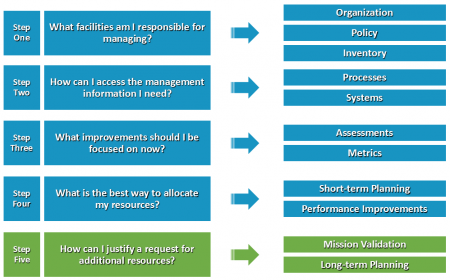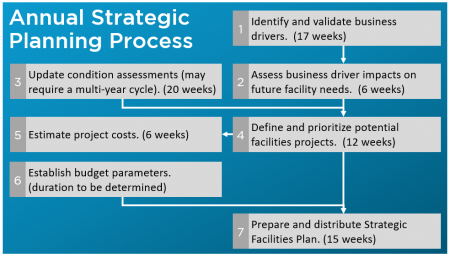In this, the sixth and final post in our series about high-performing Facilities Management Organizations (FMO), we take a look at another critical skill area that will help to ensure long-term success.
Since the FMO leader has completed work on her policies and guidelines, facility management technology, recruiting and training, and short-term planning, the emphasis needs to move on to planning for three years out and beyond.
Here is the framework, or maturity model, we’ve been using in this series, with the topic of this month’s post highlighted:

Shrinking budgets, cost increases, and rapidly changing priorities are the facts of life for today’s facilities leader, but despite these pressures, management still expects excellent customer service, fast response times, and a portfolio that will continue to meet strategic requirements in the future. For the long-term planning time frame, beyond three years, the picture of the future is simply a best guess, so a routinized planning cycle can keep things running smoothly.
A few years ago, a client engaged us to develop an annual strategic planning process, which is highlighted in the figure below. A step-by-step description of the process follows.

1. Identify the business drivers
In step one of the planning process, the FMO works closely with organizational leaders to identify the business drivers that will impact the plan. These strategic drivers may include new product launches, expansion into new geographic regions, or even updates to existing business processes that require adapting new technologies.
2. Estimate the impacts of the business drivers
A key outcome of this process is for the FMO to consider whether emerging needs can be met with existing facilities, or if an acquisition cycle needs to be launched.
3. Determine condition and serviceability
Conducted in parallel with steps one and two, in step three the FMO determines the condition and serviceability of the buildings currently in the portfolio. For smaller facility inventories, this process may be completed in less than a year, but for larger and more complex portfolios a multi-year effort may be required.
4. Compile known requirements
During step four, the FMO compiles its list of proposed projects, based on known requirements. These may originate with the condition data developed in step three, or they may be capital projects derived from the business drivers identified in steps one and two. Every FMO prioritizes projects differently, but that process is also part of step four.
5. Develop cost estimates
In step five, the organization develops cost estimates for each of the projects that have been identified, work that can be completed in parallel with step four. Once the budget is complete in step six, the FMO will have a good idea of which projects it can execute during the plan.
6. Allocate the budget
During step six, senior leadership develops and allocates the budget. The FMO typically participates in this effort by providing a draft budget, but senior leadership makes the final decisions. Once the budget information is passed back to the FMO, it can be compiled into the strategic plan in step seven, completing the cycle.
The completed strategic plan provides guidelines for developing new facilities and maintaining existing ones. Because the plan has been coordinated with leadership, business units, and other stakeholders, it is well-aligned with corporate direction, so the FMO can be confident that the portfolio will continue to support the organization’s business objectives.
Our five-step FMO maturity model is straightforward, but it outlines a challenging journey that can take a year or more to complete. Still, we’re confident that by improving each of the key competencies – inventory, systems, processes, metrics, budgets, and planning, and by completing the steps described in these posts, your team will also become a high-performing facilities management organization, just as our clients have.
This concludes our series on the high-performing facilities management maturity model. Stay tuned to the Markon blog for more insights on facilities management – we’ll have new posts on these topics very soon.

